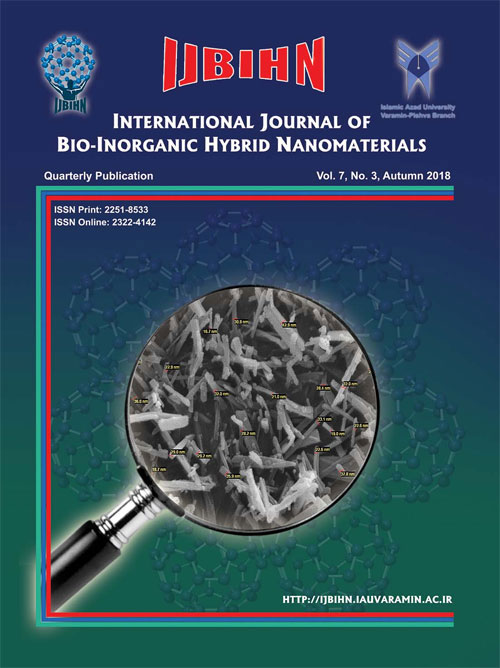فهرست مطالب

International Journal Of Bio-Inorganic Hybrid Nanomaterials
Volume:9 Issue: 4, Winter 2021
- تاریخ انتشار: 1400/10/08
- تعداد عناوین: 6
-
Pages 195-202
The purpose of this study is to investigate the graft copolymerization of 2-hydroxy propylmethacrylate (2HPMA)-Acrylic Acid (AA) compound within poly (Ethylene terephthalate) fibers in thepresence of Benzoyl Peroxide Bz2O2 initiator. The modified fibers have been used as a new adsorbentto eliminate Cethyl Pyridinium Bromide (CPB) for the aqueous solution. Fibers characterizations havebeen done using CEC, BET, TGA, FTIR, and SEM methods. The impacts of different parameterssuch as pH, adsorbate concentration, adsorbent quantity, and time have been investigated. pH=6.0,t=90 min, and qm=14.2 mg/g have been declared as favorable adsorption conditions. It is acceptabledue to the high stability of the PET fibers in acidic and alkaline environments.
Keywords: Acrylic Acid, Cethyl pyridinium bromide, 2-Hydroxy propyl methacrylate -
Pages 203-210
In addition to the pain, burns can cost the injured person both financially and psychologically.In this experimental study, the alcoholic extract of aloe vera and green tea and licorice, which havebeen used in traditional medicine in Iran for thousands of years, along with collagen protein of fish skinindividually, and then their double combination, triple combination, quaternary composition and Controlwas tested in 18 experimental boxes to treat skin lesions caused by Second degree burns on the skinof female rats. The results were then analyzed and then compared with a rat treated with a commercialointment called silver sulfadiazineone1%, which is available in pharmacies and used for burns. Theresults showed that the combined use of herbs interferes with the treatment of burns, and others causea synergistic effect and accelerate the treatment, and even faster than the commercial drug sulfadiazinesilver.
Keywords: aloe vera, Collagen, Cytotoxicity, Green tea, licorice, Side effects, Synergistic effect -
Pages 211-220
As a virtual heritage the development of the augmented reality projects that intended tocommunicate the significant of architectural heritage requires to contribute the subject by discussing thecase study which was held in Istanbul. Findings of the evaluation process revels that the architecturalheritage is the most important valuable materials for designer. The evaluations process was notembodied with the application and participants benefits and it gave researches feedback and theopportunity to enhance the application for the future.
Keywords: Argument reality's, Cultural heritage, Evaluation heritage, Heterogenize Architecture, Nano Architecture -
Pages 221-231
A flame atomic absorption spectrophotometric (FAAS) method for the determination oftrace Co(II) after adsorption of synthesis modify Multi walled carbon nanotubes carboxylate has beendeveloped. Applying a facile and accessible sample preparation method is highly important before theexperimental analysis process. In the current study, a technique was introduced for preconcentrationand analysis of trace amounts of Co(II) ions in water samples. The important parameters in the analyticalprocedure of Co(II) ions were optimized such as the pH of extraction, amount and type of elution solvent,time of extraction, and the effect of another ion. Analytical parameters such as the concentration factor,the limit of detection (LOD) of the technique, and relative standard deviation (RSD %) were achieved as20, 9.0 μg L-1, and 2.7%, respectively.
Keywords: Co (II) ion, Modified nanotube carbon carboxyl, Preconcentration of heavy metals, SPE -
Pages 233-239
Nanogels are nano-sized hydrogel networks formed by chemically or physically crosslinkedpolymer particles. Their colloidal stability affords them as good candidates for drug delivery systems.Like nanoparticles, nanogels are injectable and responsive to environmental factors, such pH, andtemperature. This work presents a facile and large-scale fabrication of poly(acrylic acid) (PAA) hollownanogels via in situ Pickering miniemulsion polymerization method. Cross-linked polyacrylonitrile (PAN)nanoparticles with hollow structure were prepared by using hydrophobic solvent as liquid core. Thecomplete hydrolysis reaction process of PAN shell leads to the successful formation of hollow PAAnanogels. The properties of PAA nanogel were characterized by FT-IR, Scanning electron microscopeand Dynamic light scattering. It is found that the nanogels have a hollow core-porous shell structure.Protein, bovine serum albumin (BSA) was used as model drugs to investigate their loading abilitiesas versatile drug-delivery vehicles. The nanogel exhibits high loading ability to protein. The maximumBSA loading capacity of PAA nanogel can reach at pH=5. This high loading capacity may be related tothe hollow core-porous shell structure of PAA nanogels. Considering the high stability of the materials,simple and mild preparation procedure, high loading capacity, and ability to protect biological agentsfrom denaturation, PAA nanogels should be promising drug-delivery carriers for drug-delivery systems.
Keywords: BSA, Drug delivery, Nanogel, Pickeing miniemulsion -
Pages 241-251
Perovskite nanocrystals of ZnTiO3 and CdTiO3 with the cubic and orthorhombic structureswere synthesized using the hydrothermal method. The crystal structures confirmed by XRD, morphologyand particle size, chemical composition, and surface chemical features of samples synthesized areevaluated through, Fe-SEM, TEM, EDX , FT-IR, and BET analyzes. The average crystallites sizeZnTiO3 and CdTiO3 perovskite were determined 12.03 and 43.7 nm, respectively by Debye Scherer’srelationship.The Optical and photocatalytic properties of ZnTiO3 and CdTiO3 are investigated byDRS (Differential reflectance spectroscopy) and UV-Vis analysis, respectively. The Ebg value (bandgap energy) of the perovskites was obtained using Tauc plots. The cubic ZnTiO3 showed Ebg=3.11 eVagainst the CdTiO3 with Ebg=3.39 eV. The photocatalytic activities of perovskite ZnTiO3 and CdTiO3nanocrystals were evaluated for degradation Congo red (CR) and Crystal violet (CV) pollutants. TheZnTiO3 degraded both the CR and CV dyes with high efficiency (91% and 72%) compared with CdTiO3perovskite (51% and 9.7%) under 60 min of the sunlight irradiation. This high performance is affectedby factors such as narrowing of the Ebg, the larger surface area, smaller crystal size and the existence ofthe hierarchical porous in the structure of the ZnTiO3 than CdTiO3. The kinetics studies revealed the rateconstant of photodegradation of CR anionic dye by both of the perovskite as-synthesized is greater thandegradation of cationic CV. The decomposition of the crystal violet fits the pseudo-first-order kinetic,while the degradation of the CR follows both the pseudo-first-order and the pseudo-second-order kineticaccording to R2> 0.9.
Keywords: Azo Dyes, CdTiO3, Perovskite nanocrystal, Photocatalytic, ZnTiO3

